You walk into the garden and you see your cucurbit plants or seedlings are suddenly looking in rough shape! Your cucumbers, winter squash, summer squash, melons, and pumpkins are all wilting, full of holes, or just plain ole dead! What do you do?
Well, first you identify the problem—and we’re here to tell you it’s a good chance your problem is the lowly cucumber beetle. In all stages of plant life, these beetles can do damage. In addition to the plant damage done by feeding, these beetles also hit your cucurbits with a one-two-punch by transmitting bacterial wilt along the way. There is no easy solution to stop cucumbers beetles, but preventative measures and control practices can help bring your infestation under control. Let’s get started!
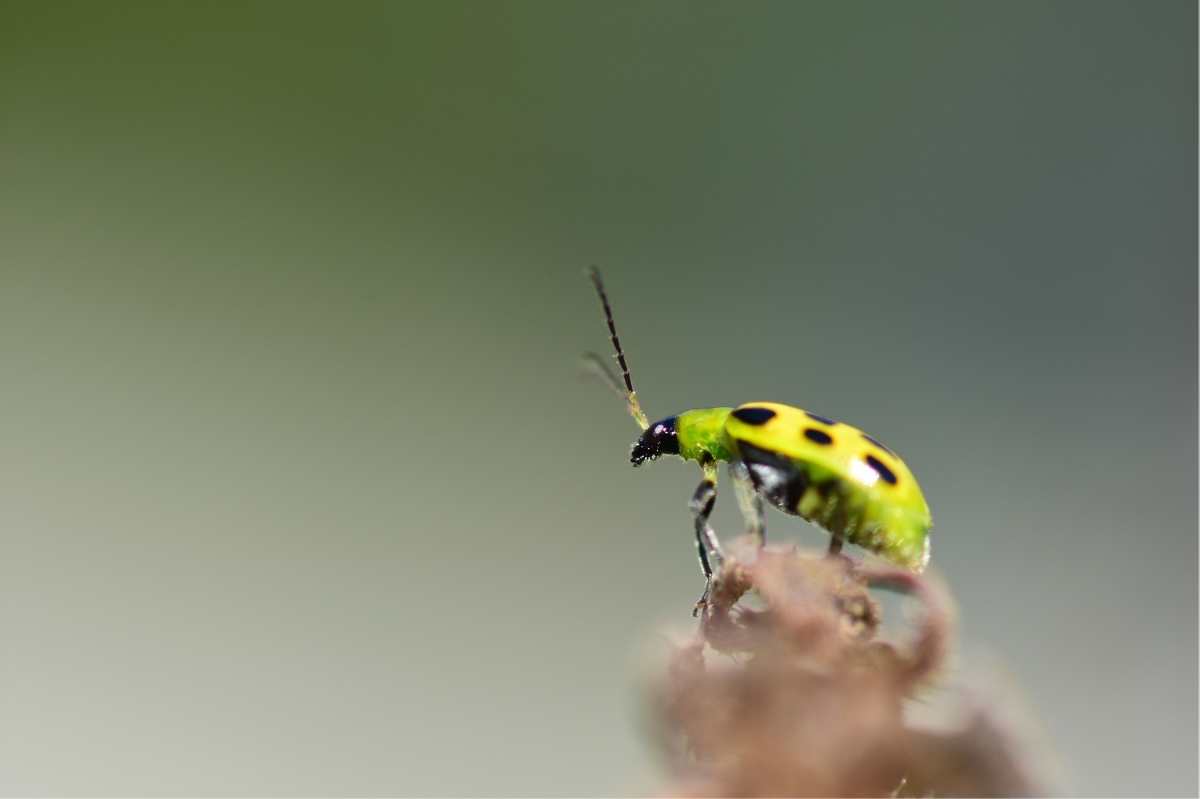
Table of Contents
What do cucumber beetles look like?
There are six species of cucumber beetles in the United States, but two of them—the Striped Cucumber Beetle (Acalymma vittatum) and the Spotted Cucumber Beetle (Diabrotica undecimpunctata howardi) are the most common cucumber beetles you’ll find causing damage in the garden. Both beetles are around 1/5″ long and 1/10″ wide. These small beetles have yellowish wings.
How to Identify a Cucumber Beetle
While there are six species of cucumber beetle in the United States, the vast majority of infestations will be from one of these two. Here’s how to identify the adult beetles:
Striped cucumber beetle (Acalymma vittatum)
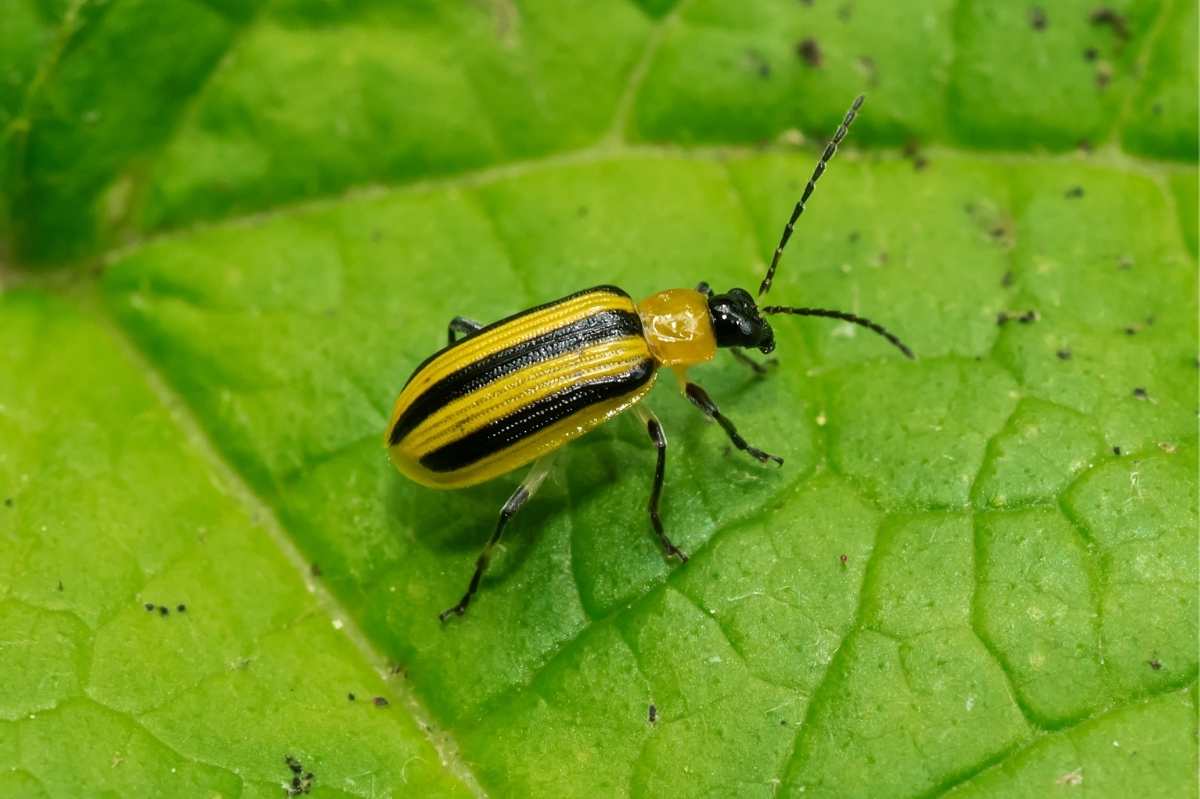
Eggs
- Orange-yellow in color
- Laid in groups in the soil at the base of host plants
Larva
- Also known as the Western Corn Rootworm
- About 3/8 inch long and off-white in color
Adult
- About 1/5 inch long and 1/10 inch wide.
- Yellow wings with three longwise black stripes from head to tip.
- Black head and antennae.
- Orange-yellow prothorax (the area behind the head).
Spotted cucumber beetle (Diabrotica undecimpunctata howardi)
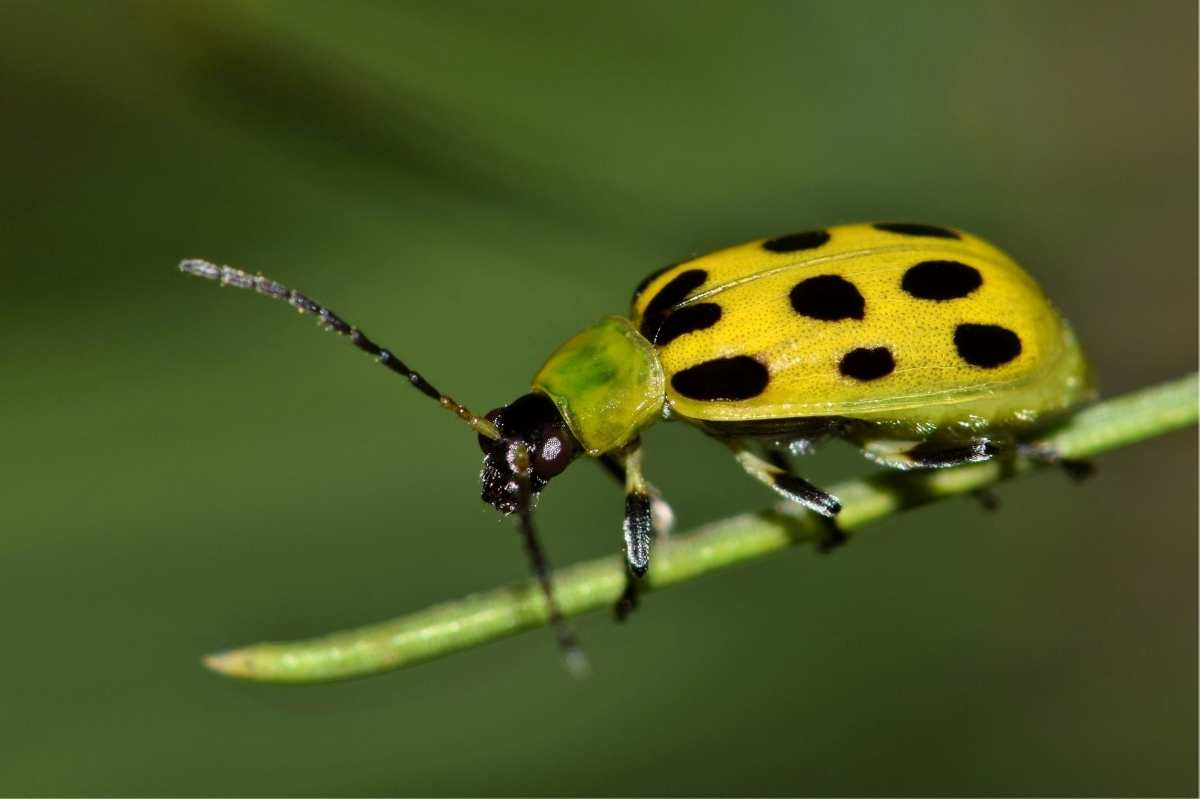
Eggs
- Orange-yellow in color
- Laid in groups in the soil at the base of host plants
Larva
- Also known as the Southern Corn Rootworm
- About 3/8 inch long and off-white in color
Adult
- About 1/5 inch long and 1/10 inch wide.
- Yellow wings with 12 black spots on their wings.
- Black head and antennae.
- Orange-yellow prothorax (the area behind the head).
What do cucumber beetles do?
Cucumber beetles are absolute destructors for your cucurbits. They are not picky about what parts of the plant they’ll eat. The mature beetles feed on the foliage of seedlings and mature plants. The cucumber beetle larvae feed on the underground roots and stems after they hatch.

Most mature plants can bounce back from a well-controlled minor infestation, but a large infestation or an infestation on small seedlings can cause irreversible damage.
Even worse, cucumber beetles (in particular striped cucumber beetles) can carry the bacteria (Erwinia tracheiphila) that causes bacterial wilt inside their stomach, which means the disease spreads via their feces and contact with their mouthparts when they munch of a leaf.
Plants infected with bacterial wilt will begin to wilt (hence the name!) and the leaves will discolor before eventually dying completely. The wilting spreads rapidly once the plant is infected, and within a few days, the entire plant can die. This disease infects the plant’s vascular system and causes plants to wilt. Once a plant is infected with bacterial wilt, there is no saving it. The plant must be removed and destroyed.
Bacterial wilt affects cucurbits differently. Cucumbers and muskmelon (cantaloupe) are the most prone to death by bacterial wilt. Squash, pumpkins, and watermelons are generally pretty tolerant or even resistant to bacterial wilt.
Growfully Protip
Bacterial wilt isn’t the only cause of wilting in cucumbers, squash, and other cucurbit plants. Other causes of wilting can be squash bugs, squash vine borers, dehydration, cucumber mosaic virus, or even just a hot, sunny day! Make sure to look for signs of a disease or insect before diagnosing.
Are cucumber beetles harmful?
In small numbers and on mature plants, cucumber beetles are relatively harmless if kept under control. On seedlings or in large numbers, cucumber beetles themselves can become very destructive. It is important to note that even a small number of cucumber beetles can spread bacterial wilt if they are infected—so it’s best to deal with the problem early on.

What are some natural enemies of the cucumber beetle?
It’s not a quick fix, but increasing the natural predators of cucumber beetles is one of the best methods for preventing an infestation. Beneficial insects that are natural enemies of cucumbers beetles are:
- braconid wasps
- beneficial nematodes
- ladybugs
- green lacewing
- assassin bugs
- soldier beetles

You can attract these beneficial insects by planting companion crops or nearby cover crops like cowpea (Vigna unguiculata (L.)), and sweetclover (Melilotus officinalis (L.)), which have been proven to increase yield in cantaloupe crops by reducing cucumber beetle populations. Any plant that increases beneficial insect populations (flowers in the aster family are particularly helpful) can also help control cucumber beetles.
What plants keep cucumber beetles away?
Another option for companion planting to reduce the cucumber beetle population is to plant to repel them. This is done by interplanting with high-scent herbs and flowers to confuse the cucumber beetles so they don’t find your cucurbits. Fragrant plants like marigold, tansy, sage, and catnip are all good options.
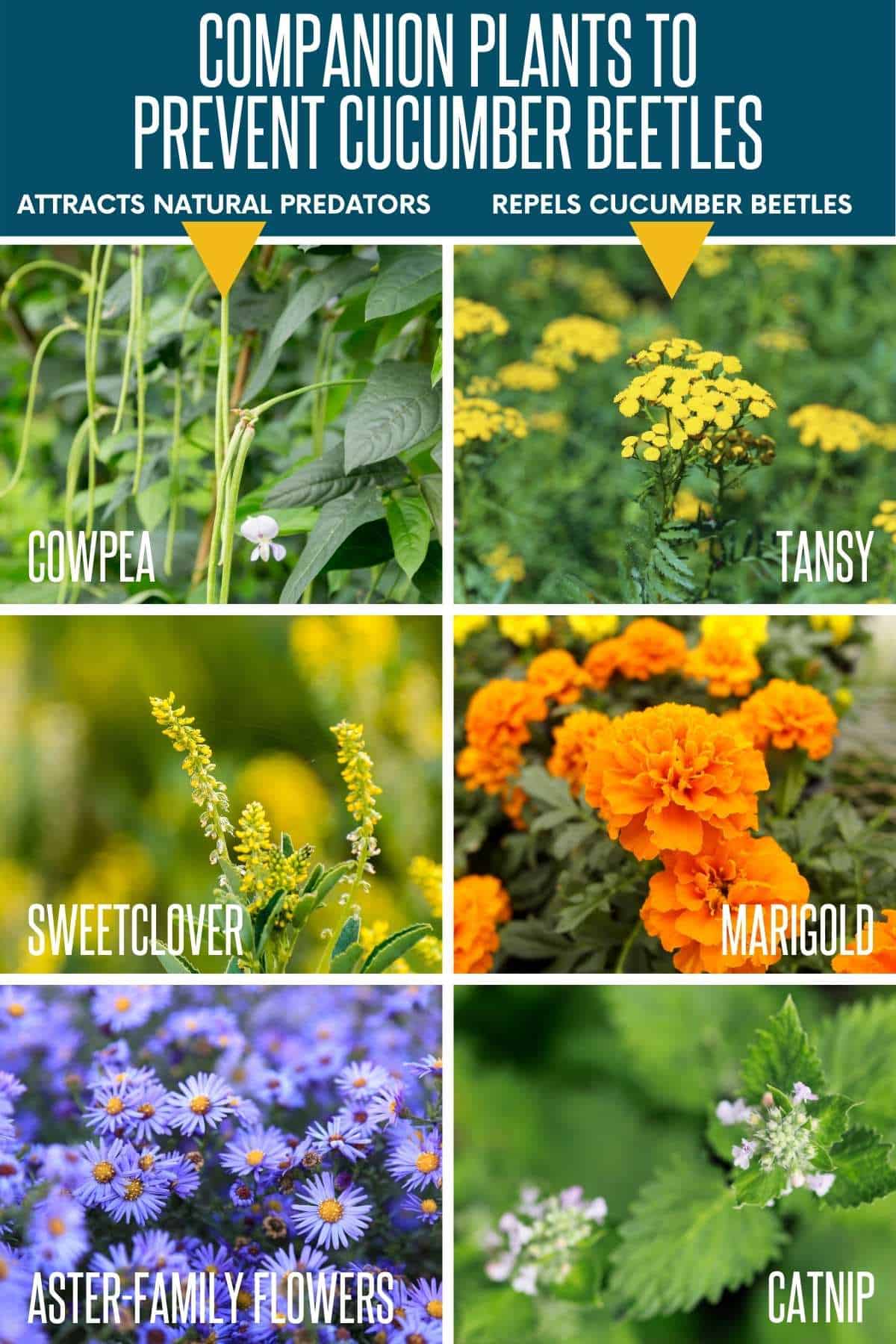
Another way of planting to prevent cucumber beetles is to use a trap crop. A trap crop is a plant that is used as a sacrificial lamb in the garden. You plant a crop that is particularly tasty to cucumber beetles at the perimeter of the garden two weeks before your main crop. The beetles are attracted to that plant and leave your others alone. You then destroy the beetles on the trap crop using either mechanical (flaming, vacuuming with a shop vac, or handpicking) or biological control (organic insecticides).
How to Prevent Cucumber Beetles
Prevention (AKA: cultural control) is the very best way to make sure cucumber beetles don’t destroy your cucumbers, melons, and squash. Here’s our prevention plan:
- Clear out leaf litter and garden debris from the previous year. Cucumber beetles overwinter in leaf litter and mulch in the garden.
- Rotate your crops. Make sure not to grow cucurbits before or after one another in the garden, if possible.
- Plant crops that attract beneficial insects. Plant crops like cowpea, clover, milkweed, and other pollinator-friendly plants to attract the natural enemies of cucumber beetles to your garden.
- Interplant your cucurbits with plants that repel cucumber beetles. Heavy companion planting of fragrant herbs and flowers like marigolds, tansy, sage, and catnip can help confuse and repel the beetles.
- Try a trap crop. Plant a cucumber plant at the perimeter of your garden two weeks before your other cucurbits. As cucumber beetles flock to that plant from late April to early June, destroy them using mechanical or biological control methods.
- Try row covers. Insect netting row covers can help prevent the infestation of new cucumber beetles, but they cannot prevent an infestation that comes after eggs hatch from overwintered beetles. You also must remember to remove your row covers to allow access for pollinators when your plants are flowering.

How to Get Rid of a Cucumber Beetle Infestation
So say you didn’t get a chance to put in a prevention strategy, or you did and you still have an infestation. What do you do now?
Growfully Protip
Since many insects, pests, and cultural concerns can cause wilting in cucumbers, make sure you can identify adult beetles on your plants before treating for cucumber beetles.
Mechanical/Physical Control Methods
Interrupting the life cycle of the cucumber beetles is what you’re trying to do, and although tedious, that’s possible through some mechanical control methods:
- Hand-picking: Small infestations can be reduced by handpicking the adult beetles and then dropping them in a bucket of soapy water to kill them. Also, make sure to smash any larvae or eggs you see.
- Vacuuming: A shop vac or a leaf vacuum (with a bag attached) can be a good way to suck up heavy infestations. This is particularly useful when managing infestations on trap crops.
- Burning: For heavy infestations, using a weed torch can be a good way to kill all eggs, larvae, and adult beetles. This, however, will also kill your cucurbit plant as well. Flaming is a good way to regenerate a bed in the garden that has had a heavy infestation in the past and make it safe for future planting.
Biological/Chemical Control Methods
To help protect pollinators, it is best to treat heavy infestations of cucumber beetles with a combination of biological, cultural, and mechanical control methods (AKA: Integrated Pest Management). Relying strictly on chemicals is often ineffective, it increases the prevalence of beetles who are immune to the chemicals, and it’s bad for our beloved bees!
- Kaolin clay: Kaolin clay leaves a film behind that cucumber beetles find unattractive for egg-laying, feeding, and crawling around. Just sprinkle it around the plant foliage when you’ve identified damage from adult beetles. Or you can mix it with water and spray it on using a spray bottle, making sure to cover all foliage—the spray dries into the film. Make sure to apply when bees and other pollinators are not active.
- Neem oil: Neem is a plant-based pesticide that prevents the cucumber beetles from feeding, and they eventually die from starvation. Neem oil is considered moderately toxic to bees and other pollinators, so it’s important to only apply during late evening, night, or early morning AND when plants are not in bloom.
- Pyrethrum: This is an organic pesticide derived from the Pyrethrum daisy that is loaded with chemicals called pyrethrins that are toxic to insects. Pyrethrum is highly toxic to almost all insects—it is deadly for beneficial insects and pollinators, and should be used as a last resort and only when bees are inactive.
- Spinosad: Spinosad is a natural substance made of bacteria that can be toxic to insects. This bacterium causes paralysis and eventually death in insects. Spinosad is moderately toxic to earthworms, and is very highly toxic to bees—however, the toxicity is reduced greatly after the spray has dried.
Growfully Protip
We recommend a combination of prevention/cultural control and mechanical controls first when managing cucumber beetles. To protect pollinators and other beneficial insects, chemical control methods should be a last resort.
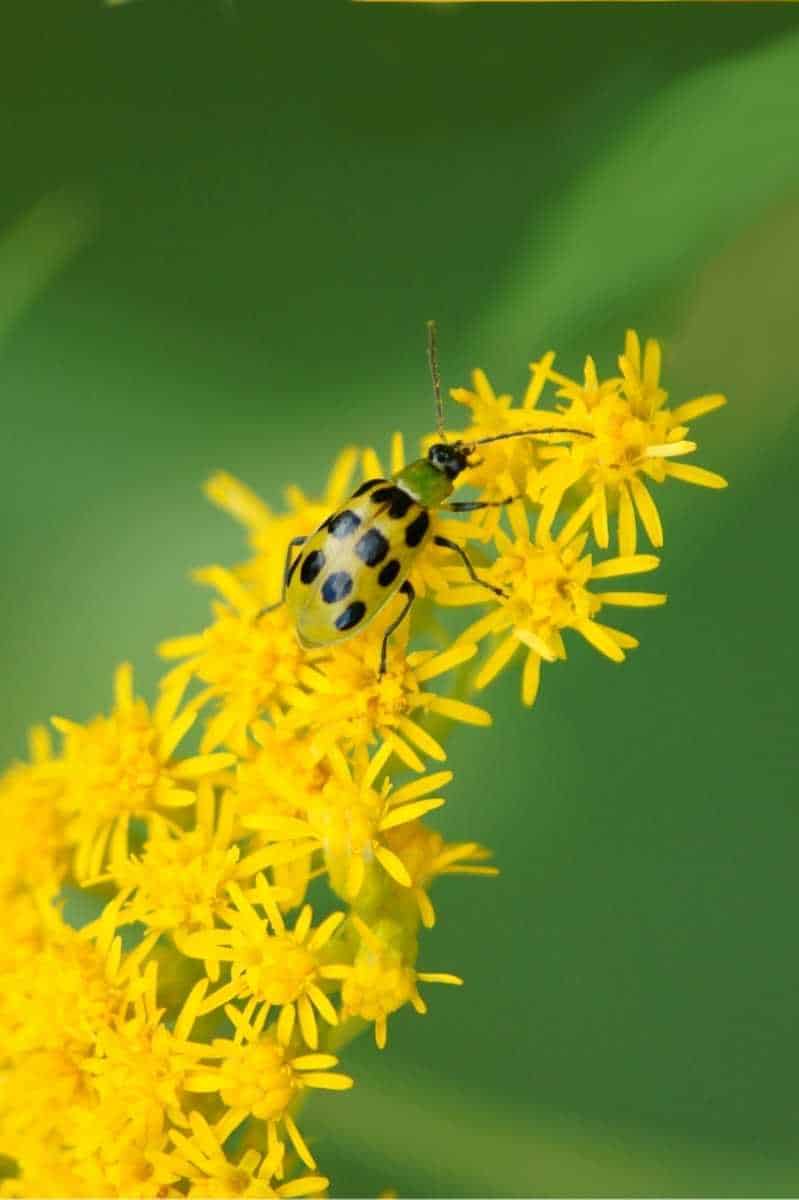
As with most pests in the home garden, prevention is the absolute key to success when it comes to stopping cucumber beetles from infesting your crops. We’re sure if you follow our plan, you’ll have a bumper crop of cucumbers, melons, and squash this year!

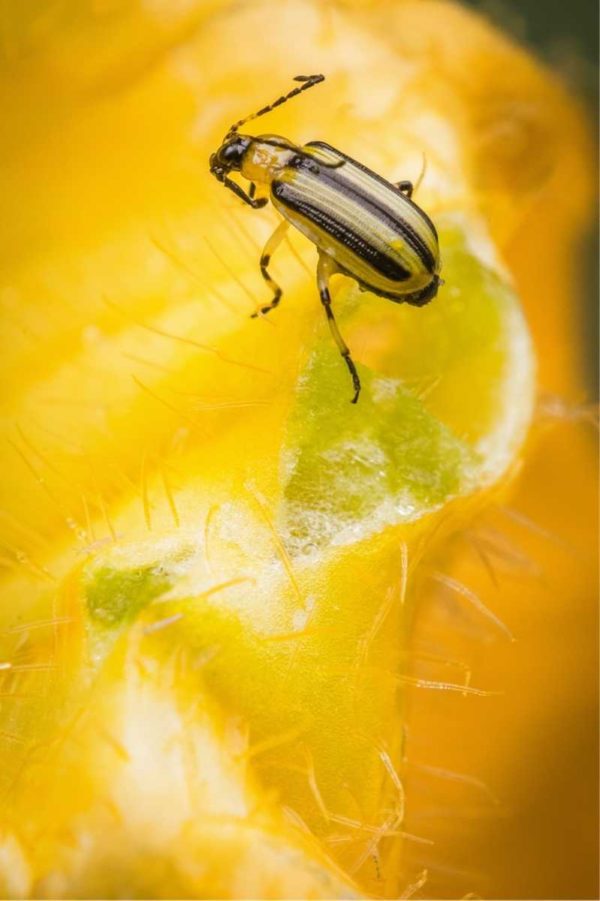






How often should you treat with nematodes
We just applied them once this year, and had really great success with keeping away both army worms and cucumber beetles!
I will certainly try your methods even though I’m getting off to a late start.
I have never learned so much in one article!
Thank you so much.
Hi Cassie! I too was a Master Gardener for almost 2 decades, but I have never been infested with cucumber beetles like this. I bought some diatomacious earth but am afraid to use it due to possible lung infections. I was wondering if just skipping a year of planting my cukes at all will have the emerging beetles leave to find another place to play and reproduce. I would always plant in the same area and had them under control and grew enough to share but not anymore. It seems that if I take away their food and don’t grow any this year, they will grow else where. What do you think? Thanks for your time and thank you for being a Master Gardener!
Yes, not planting any curcubits for a season would definitely help. Good luck!
Planting radishes as a deterrent in and around cucumbers plants works really well. The radish plants remain in the ground the whole season as a protection from the beetles. Planting radishes really works. I’ve tried numerous strategies such as those mentioned in this article. I even grew my cukes in cages, sewed bags out of row cover material and completely covered the cages burying the edges in the ground and that didn’t stop them either.
I tried covering big yellow disposable plates with sticky stuff and using those as a decoy for the yellow flowers on the cukes. It didn’t save the cukes from bacterial wilt.